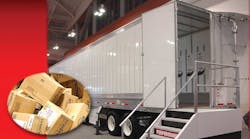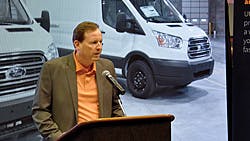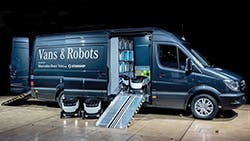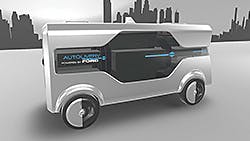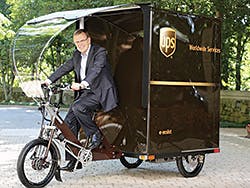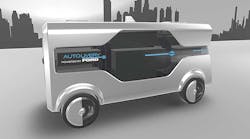Transporting goods from their source of manufacture to their ultimate destination may seem like a marathon race, but it’s actually a relay.
Each leg of the relay serves its purpose—ocean freight, truck load carrier, LTL, air freight, rail, intermodal, parcel delivery.
The last leg of a relay race draws the most attention. Track coaches typically assign their fastest, most reliable runner to anchor the final leg of the race. It’s where many relays are won and lost.
In today’s transportation industry, the final leg of the shipping relay is almost always the most expensive. And it is the one undergoing the most transformation.
Why? Because the traditional anchor of this relay does not want to run the race anymore.
Instead of going to the store, putting goods in a cart, checking out, and driving their purchases home, consumers increasingly are opting to do this online. When we buy online instead of a brick and mortar store, we in effect are downloading the final transportation function onto the company that made the sale. We don’t load our purchase up and drive it home. It’s the vendor’s job to get it to us. And as an added bonus, shipping is free.
More than anything else, a combination of fast shipping and free shipping promises to change the way freight is transported. Is fast and free sustainable? That is one of many questions that are being asked, and it is one reason why shippers are seeking ways to wring every possible cost out of the supply change.
“The world is changing at a fast clip, and I don’t know if we know where it’s heading,” says Craig Bennett, senior vice-president of sales and marketing at Utility Trailer Manufacturing. “The Amazon effect as I call it will change trucking’s role dramatically.”
Repercussions promise to affect vehicle manufacturers, truck fleets, and shippers.
“Trucking will be going through the fulfillment centers and distribution centers at a higher rate,” Bennett says. “And there probably will be smaller vehicles created to do more of the neighborhood delivery. Utility is not in that world at this point, but we are aware of the changes and are evaluating what our response should be.
“I think some portion of the industry will move to smaller shipments. We make 28-ft reefers and flatbeds as short as 24 feet long. How small can we go? I don’t know, but we are looking at that and how much sense does it make. We also are evaluating the size of the tractor that will be required. Will it be a Class 5? Class 6? Class 7? Or will it be a parcel delivery van—even an insulated parcel van? I don’t have all the answers, but it certainly is a trend.”
“This is a market that is growing and is not going away,” says Great Dane vice-president Chris Hammond. “My wife and I automatically get Tide detergent delivered to our door just before we run out. Our garbage bags are delivered the same way. It’s all automatic. These types of transactions are just beginning, and it is going to change trucking in ways we can’t imagine.”
“We noticed changes in freight trends about three or four years ago,” says Brent Yeagy, president and chief operating officer at Wabash National. “Our largest customers began seeing a shift in freight patterns, and they recognized a risk to their truckload business as more metro-friendly means of transportation became needed. The majority of our customers have begun seeing disruptive business practices.
“All of the names who we deal with are learning about this. They are recognizing that their standard business model needs changing, but no one really knows how extensively or what specifically needs to change. This is keeping trucking management up at night. They also know that conditions like this form the kind of environment where someone from outside the industry can come in with a new way of doing things—something that will completely revolutionize the industry.”
Putting the white gloves on
Final-mile operations are more than simply delivering packages for Amazon. Major trucking companies are now providing a wide range of retailers with the ability to offer the same ability to deliver that large e-retailers have developed.
“We used to think of final-mile operations in terms of small package delivery,” Yeagy says. “But now people are ordering washers and dryers online. How are online retailers getting these types of products to the customer’s doorstep? It’s why several of our major customers are beginning to offer “white glove” delivery service.
J B Hunt, for example, has been offering final-mile delivery for several years. The company offers a choice of services including:
• Threshold. Drivers get the purchased to the front door.
• Enhanced. This gets the purchase into the house and includes unpacking, inspection, and debris removal.
• White glove. This involves delivery by a two-person crew wearing uniforms and whose background has been checked. They deliver at pre-arranged times, and their performance is evaluated through post-delivery customer surveys.
Other major trucking companies, including Schneider National and Old Dominion, have developed similar final-mile operations.
Implications of fast and free
So what can truck body and trailer manufacturers do to better meet the needs of customers in an era of fast and free shipping?
We asked a variety of trailer manufacturers about what their customers who are in the final-mile market want from commercial trucks and trailers. The answers tended to reflect standard features and benefits—but on steroids.
“Some trucking companies in this arena pay a penalty if the load doesn’t arrive on time,” one manufacturer said. “Suddenly everything becomes more urgent. Reliability becomes more important than ever.”
Beyond reliability, customers mentioned several other product attributes which fast and free shipping magnify. They include:
• Optimization of equipment. How can the vehicle be as productive as possible?
• Flexibility. Is it possible to design a general truck (or trailer) that can do the work of multiple specialized units?
• Customized cargo space.
• Ergonomics. When drivers are difficult to hire and retain, how can truck body and trailer manufacturers make their jobs safer and more comfortable?
• Maneuverability. Is the vehicle nimble in congested, urban environments?
Manufacturing truck bodies
Two of the North America’s largest trailer manufacturers have responded by developing truck bodies for final-mile operations. Great Dane and Wabash were prominent at The Work Truck Show with bodies targeted specifically for this application.
“We see this as a huge opportunity,” says Mayo Rude, director of truck body sales at Great Dane. “The logistics for making e-commerce work are mind boggling. We know we can provide customers the equipment they need. The challenge right now is that things are changing constantly. We have to understand what they want to do before we can say what we can do to meet their needs.”
Great Dane’s relatively recent acquisition of Johnson Truck Bodies has helped the trailer manufacturer’s entry into the truck body manufacturing business. (For details, see our story on Great Dane’s truck body manufacturing operation within its Brazil, Indiana, trailer plant in the December 2014 issue of Trailer/Body Builders.)
Great Dane has been promoting its new “final mile” dry-freight vans that mount on medium duty trucks. These are being sold under the Great Dane brand. Meanwhile, Rude says Johnson will be introducing new product that will be particularly suited for maneuvering through congested urban areas.
New to the market
Wabash leveraged its history in trailer manufacturing, along with its proprietary Duraplate technology to enter the truck body market last year.
“We began building truck bodies so that we could be ahead of the customer,” Yeagy says. “When customers realize they need to add truck bodies, we want to have a product available.”
Great Dane and Wabash both believe their history of manufacturing trailers has helped them gain acceptance as manufacturers of truck bodies.
“We have found that some major fleets are looking to expand into straight trucks, but they are looking for the same value proposition as the trailers they have been buying,” Yeagy says. “They want superior design, materials, and performance. They want longer life, the same maintenance practices, and aftermarket parts commonality. The faster the freight has to be delivered, the more important reliability becomes. This is a big need. So we don’t want to manufacture truck bodies the way they have always been built before. We have people working almost fulltime on this to provide the answer to this question: How can we do it better?”
Wabash has established a Final Mile & Distributed Services operation headed up by Kevin Page. A recent hire, Page is tasked with driving further commercialization of Wabash’s new Final Mile Series and Cold Chain Series truck bodies. He also will direct and manage growth in the aftermarket parts and retail businesses.
Do you want to play?
For Great Dane and Wabash, trailer manufacturers are participating in the final mile market with truck bodies. Others are asking themselves a different set of questions such as:
• Should we pursue this market?
• Can we participate in this market by adapting our current product?
• What is the potential risk to us as trailer manufacturers as more “metro-friendly” modes means of transportation became needed?
• Will our product line need to be expanded to enable us to participate in this market more fully?
Offering products for final mile service may not be as involved as one might think. When we ask companies currently serving this market what their customers expect, the answers tend to be remarkably similar to what most customers are looking for: light weight, cost savings, durability.
“Nothing unusual about that,” a trailer manufacturer says. “But our customers haul freight. And when their customers are under pressure to provide fast and free shipping, then traditional values such as weight savings, operating savings, and reduced maintenance are more important than ever.”
Good news for truck bodies
The growth of final mile service is good news for truck body manufacturers, especially those who are already in the business of producing delivery trucks.
“This has been our specialty for 65 years,” says Carrie-Ann Flank, vice-president of sales and marketing at Morgan Corporation. “We see things changing, though. Even more emphasis on weight savings, which means we as a van body manufacturer need to make our bodies lighter. Our customers are moving toward smaller trucks that don’t require CDLs. They are buying smaller engines in order to improve fuel economy. We are seeing more interest in cargo control equipment.”
Supreme’s Genie Bandy agrees.
“The biggest thing from our perspective is that we see trailer fleets buying more truck bodies,” she says. “We continue to work with our customers to get costs down, and to improve the ergonomics of our trucks in view of the driver shortage and aging driver population.”
All of these factors present opportunities for manufacturers and distributors alike to design and equip vehicles tailored to get goods in and out of trucks as quickly and painlessly as possible.
To date, online retailing has mostly involved products that fit in an envelope, a box, and a dry-freight van. Those involved in refrigerated transportation see this as an additional source for growth.
Successful home delivery of groceries is something the grocery industry has been considering for decades. It was gaining momentum among some major chains when the dot.com bubble burst.
“Grocers such as Safeway and Albertsons, I believe, recognized that the programs they introduced back then were workable, but that they were just ahead of their time,” Mayo Rude says. “These companies are convinced that grocery delivery isn’t going away. We see this as a huge opportunity.”
“To me, one of the more interesting questions is this: When will the public be comfortable buying food this way?” Hammond says. “Right now, when we shop for groceries, we still want to touch our food, lift it up, and make sure that we are buying the best one on the shelf. Nobody wants to buy the last banana. When customers reach the point where they trust the vendor to deliver quality produce and other perishables, this way of buying groceries is going to explode.”
Chassis manufacturers weigh in
Truck manufacturers are developing programs designed to address this topic.
Ford announced earlier this year that it intends to have a fully autonomous, SAE Level 4-capable vehicle for commercial application in mobility services such as package delivery fleets in 2021.
The company has been touting possible solutions such as autonomous vehicles and drones which could work hand-in-hand to transform city deliveries.
Ford recently displayed its “Autolivery” service concept at Mobile World Congress in Barcelona, Spain. Ford personnel envision electric self-driving vans used together with drones to pick up and drop off goods and packages in urban areas. The focus was not on the final mile but on the last 15 meters of the delivery process.
Mercedes displayed similar thinking with its $17.2 million investment in London-based Starship Technologies. Starship Technologies was co-founded in 2014 by two former Skype executives to provide a new way of delivering small packages. Daimler demonstrated the results of their Starship partnership at the Consumer Electronics Show earlier this year. Its “Robovan” prototype upfits a Mercedes van with specialized van interiors to accommodate a batch of ground-based drones. The van serves as the “mother ship” as the drones deliver the volumetric equivalent of three shopping bags of food or merchandise to locations up to three miles away. The process, which takes approximately 30 minutes, is not as fast as airborne drones, but it does not face the same regulatory issues.
Starship Technologies has begun pilot programs in Europe, including food delivery service.
Looking ahead
Ask a trailer or truck body or trailer manufacturer what the future holds for final mile operations and the answer will be one of uncertainty.
“The model for the final mile is not set. It’s incredibly dynamic,” Yeagy says. “No one really has been able to identify who or what will be the disrupter that revolutionizes the transportation industry. One thing we do know, when multiple modes of transportation are used to get freight to the ultimate customer, the final mile has always been the most expensive—by far. As shippers seek to lower transportation costs, they are going to look closely at their most expensive segment.”
“We are seeing those trends fundamentally in dry vans. It remains to be seen what will happen, but we remain confident that trailers will continue to play a major role,” Bennett says. “We live in a big country—3,000 miles across and 1,800 miles high. These miles will have to be traversed with trailers. The trailer industry is healthy and viable and will continue.”
Regardless of what the future holds, as several manufacturers told us, “this is an exciting time to be in this business.”
“E-commerce is not linear,” Yeagy says. “It’s growing exponentially. And its implications for the trucking industry promise to be more disruptive than 99% of us can even fathom at this point.” ♦









